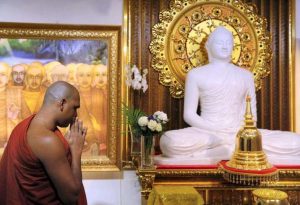
A Canadian teenager was questioned by police in Japan earlier this month for allegedly scratching his name into a pillar at Toshodai-ji a historic Buddhist temple in Nara, Japan. A Japanese tourist alerted temple staff after witnessing the alleged vandalism early in the afternoon of 7 July. The temple, which dates to the eighth century CE, is recognized by UNESCO for its cultural significance.
“The boy admitted his act and says it was done not with the intent of harming Japanese culture,” said a police official. “He is now with his parents, who were with him when the incident occurred.” (Artnet News)
The 17-year-old is accused of carving the letter “J” and the name “Julian” into a wooden pillar at the temple’s Golden Hall with his fingernails. When questioned by the authorities, the boy is reported to have said that he was just trying to pass the time.
World Heritage temple in Nara vandalized by visiting foreign teenhttps://t.co/hvEOewHeUQ#KyodoNewsPlus
— Kyodo News | Japan (@kyodo_english) July 7, 2023
“Even though it may have been done without malice, it is still regrettable and sad,” said a monk at Toshodai-ji. (Euronews)
If the teen is found guilty of destruction of Japanese cultural property, he could be fined ¥300,000 (US$2,140) or face up to five years in jail.
The incident occurred as tourism is growing in Japan, giving rise to concerns about similar acts of vandalism at historic sites. In April, the total number of foreign tourists in Japanese hotels topped 10 million. This is the first time it has hit this number since January 2020, just before the start of the COVID-19 pandemic.
An important ingredient in the rise of foreign tourists in recent months has been China’s loosening of travel restrictions.
“We foresee a continuous increase in the number of international flights from China as there has been an 11 per cent capacity increase between March and April 2023,” said Asami Chung, general manager of travel management company FCM Japan. (Japan Times)
The day after the alleged vandalism, Toshodai-ji staff posted a sign: “Please do not damage the hall. You will be punished for violating the Cultural Property Protection Law.” (The Washington Post)
The vandalism resembles a similar incident that occurred in June in Rome, where a Bulgarian fitness instructor named Ivan Dimitrov reportedly carved his and his girlfriend’s names into the Colosseum. Dimitrov, 27, begged for forgivness, saying he did not know the antiquity of the wall he was vandalizing, telling the Italian prosecutor: “I admit with the deepest embarrassment that only after what regrettably happened, I learned of the antiquity of the monument.” (Artnet News)
Toshodai-ji was built in 759 CE under the leadership of the Chinese monk Jianzhen. Built in a style similar to temples in Tang dynasty China, the temple is one of eight Historic Monuments of Ancient Nara, which was once the capital of Japan. The Golden Hall of the temple is described as “the greatest Tempyo-era structure [of the eighth century] remaining in Japan today” that has “been written about in many famous old poems.” Additionally, “The row of its pillars is reminiscent of the Parthenon of Greece.” (The Washington Post)
The temple belongs to the Risshu school, one of the six main schools of Buddhism in Japan, founded in Japan by the Chinese monk Jianzhen (Jp: Ganjin), who lived from 688–763 CE.
Read more
Japanese Police Are Investigating a Canadian Teen After He Was Caught Defacing an Ancient Buddhist Temple (Artnet News)
Canadian tourist accused of vandalizing 1,200-year-old temple in Japan (Euronews)
Teen tourist carves name into 1,200-year-old Japanese temple (The Washington Post)
Japan visitors surge to nearly 2 million in April after China eases travel curbs (The Japan Times)
Toshidodaiji Temple
Related news reports from BDG
Weekly Toyo Keizai: Buddhism Facing a “Life or Death Struggle” in Japan
Japanese Americans Commemorate Remembrance Day
Japanese Buddhist Temple Offers Immersive CGI Imagining of the Pure Land
Japanese Buddhist Conference Speaks Out on the Dalai Lama’s Succession
Mourners Bid Farewell to Japan’s Shinzo Abe at Buddhist Temple
Japanese Buddhist Monk Writes Book to Support LGBTQ+ People
Japanese University Develops Robotic Exoskeleton to Aid Buddhist Pilgrims
Japanese Buddhist Monk Combines Electronic Music and Choreography in Prayer Dance for Students












